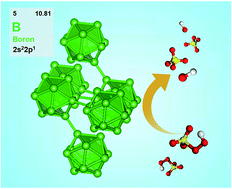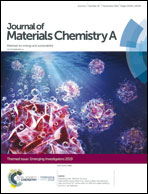Origins of boron catalysis in peroxymonosulfate activation and advanced oxidation†
Abstract
Metal-free materials have exhibited great merits as substitutes for toxic and scarce metals/oxides in environmental catalysis. In this work, amorphous boron (A-Boron) is exploited as a nonmetal catalyst for peroxide activation. It is discovered that A-Boron is exclusively reactive for peroxymonosulfate (PMS) activation for the degradation of a diversity of organic contaminants in water, including benzenes, phenolics, dyes and antibiotics. Moreover, comparative tests show that A-Boron stands out among diverse heterogeneous catalysts, such as transition metal oxides, nanocarbons and non-carbonaceous materials (sulfur, phosphorus, boron nitride, and boron carbide). Competitive radical scavenging tests and in situ radical capture analysis by electron paramagnetic resonance (EPR) revealed that both sulfate (minor contribution) and hydroxyl radicals (dominant contribution) are generated and account for the organic oxidation. Advanced characterisation techniques suggest that the boron-based catalysis stems from the short-range ordered grain boundaries and amorphous domains in A-Boron. This is further evidenced by the fact that after thermal treatment, the surface-tailored boron samples (A-B-400 to 1000) exhibit inferior activities, with 10.4% to 28.3% phenol removal compared with A-Boron (74.3%); this is due to the formation of surface boric acid/hydroxide, which blocks the active boron phases. Theoretical calculations illustrate that the (1 0 0), (1 0 1) and (1 1 0) terminations and amorphous regions of elemental boron can directly cleave the peroxide O–O bond and decompose PMS to produce reactive hydroxyl radicals, which is in agreement with the experimental discoveries. This study provides a novel metal-free catalytic system for wastewater treatment and provides the first mechanistic insights into the origins of boron-based catalysis.

- This article is part of the themed collection: Journal of Materials Chemistry A Emerging Investigators


 Please wait while we load your content...
Please wait while we load your content...